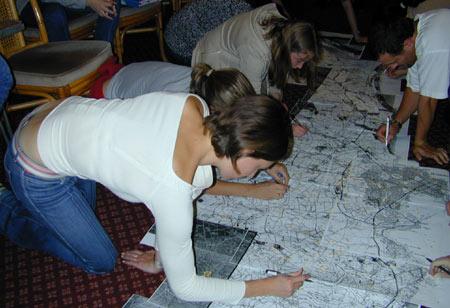
peterhead methodology
There is no getting away from the fact that a number of students lifted their eyebrows when we were explained how we were to approach the Peterhead project. I was one of them.
Raoul Bunshoten, of CHORA, have developed a methodology which involve gathering random information about the area with which he works. As any mathematician will be too eager to explain to you, one of the hardest things are to make a process 100 % random. At the same time, a mathematician may also (at least this is what Crossword Bob did at Droothy Neebors in Edinburgh), when asked by me about calculations of the area of a circle: draw an almost perfect square as a representation of a circle. Never Mind. It all made perfect sense at the time!
Mr. Bunshoten has developed his own idea of randomness. He is dealing with maps. Maps are large. And may be made even larger. Which is what we did with the maps of the Peterhead area. We enlargened them. And bought a bag of beans.
A number of beans were counted, the map laid out on the floor, and the beans thrown in the general direction of the map. Beans that missed the map were picked up and thrown again.
For this project, we started with 400 beans, but the number was later increased to 600. This was decided by mr Bunshoten, judged by the desity on the map.
Once completed, each bean represented a "beansite." The idea behind Mr Bunshoten's theory, is that you can go anywhere in the world, ask a set of predetermined questions and record the answers. The more places you go, the more information you gather. But since everyone is asking the same questions, you will get comparable answers. In his own words: "you can send out old people, young people, unemployed, working people. Whatever information they bring back will be related to the area in question, and above all: in the same format and thus comparable."
The image above show what it looked like when all the beans had been thrown onto the map. What is happening here is removing one bean at the time, and substituting the place where the bean landed with a unique number.
The following day, all students were divided into groups, sent out in the field to visit some of the sites thus selected. Once we reached a site, we asked the predetermined set of questions, recorded the answers, and moved on to the next site. The aim for the day was to get to as many sites as possible.
The persons on the image above are, seen from left: Steph, Annina, Eilidh and Steve busy in the process substituting beans with numbers on the map.